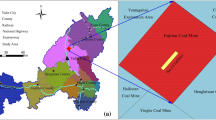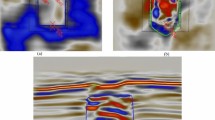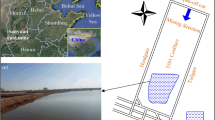Abstract
Research on the height of the water-flowing fractured zone (HWFFZ) is important for mine safety and regional eco-environmental conservation in the Jurassic coal field of northwestern China. Using the Cuimu coal mine as a case study, on-site measurement, mechanical theory calculation, and numerical simulation were used to analyze the regularity of the HWFFZ in this area. A television borehole wall imaging system with a light source allowed us to examine the size and shape of fissures intuitively, allowing the top boundary of the HWFFZ to be determined. Per mechanical theory, the overlying strata in the decreasing stress zone was simplified as a clamped rectangular plate and the formula for calculating HWFFZ was obtained by comparing the value of the ultimate deflection of the thin plate and the height of the free space in the lower part of the stratum. In addition, the dynamic development of the HWFFZ was simulated using realistic failure process analysis software. The unusual characteristics of the HWFFZ were analyzed from two aspects: the inapplicability of the traditional empirical formula and the difference of the overlying strata structure of the Jurassic and the Carboniferous Permian coalfields. These strata can be divided into layered and integrated strata in the Jurassic coalfield.
导水裂隙带高度(HWFFZ) 研究对西北侏罗系煤田煤矿安全开采和生态环境保护具有重要意义。以催木煤矿为例,利用现场监测、力学计算和数值模拟方法研究了该区导水裂隙带发育规律。带光源的钻孔孔壁电视有助于观察初始裂隙大小、形状和判定导水裂隙带顶部位置。经力学分析,将应变衰减区上覆岩层简化为固支矩形板,通过比较薄板挠曲和下部地层自由空间高度获得导水裂隙带高度计算公式。利用真实破裂过程分析软件(RFPA)模拟了导水裂隙带发育的动力学过程。从两个方面分析了导水裂隙异常特征:经验公式的不适用性和侏罗系与石炭二叠系地层结构的差异。侏罗系煤田地层可被分为层状和整体两种。
Zusammenfassung
Die Erforschung der Höhe der wasserführenden Bruchzone (HWFFZ) ist bedeutsam im Hinblick auf Grubensicherheit und Umweltschutz im jurassischen Kohlerevier von Nordwestchina. Am Beispiel der Kohlegrube Cuimu wurde anhand von Feldmessungen, gebirgsmechanischen Berechnungen und numerischen Simulationen die Regelmäßigkeit der HWFFZ in diesem Gebiet untersucht. Ein Bohrlochkamerasystem mit Lichtquelle ermöglichte die direkte Untersuchung von Spaltengröße und -form und damit der Bestimmung der Oberkante der HWFFZ. Mittels mechanischer Theorie wurden die Deckschichten in der Stressabbauzone vereinfacht als eingespannte rechteckige Platte betrachtet, die Berechnungsformel für die HWFFZ ließ sich durch Vergleich des Werts der maximalen Durchbiegung der dünnen Platte und einem entsprechenden Abstandsmaß im unteren Schichtbereich berechnen. Zudem wurde die dynamische Entwicklung der HWFFZ mittels realistischer Versagensprozessanalyse (RFPA) simuliert. Die ungewöhnlichen Eigenschaften der HWFFZ wurden unter zweierlei Aspekten analysiert, nämlich der Nichtanwendbarkeit der herkömmlichen empirischen Formel sowie der Strukturunterschiede der Eigenschaften der überlagernden Schichten der jurassischen bzw. permokarbonen Kohlereviere. Im jurassischen Kohlerevier können geschichtete und integrierte Schichten unterschieden werden.
Resumen
La investigación sobre la altura de la zona fracturada con agua fluyente (HWFFZ) es importante para la seguridad de las minas y la conservación ecoambiental regional en el campo de carbón Jurásico del noroeste de China. Utilizando la mina de carbón de Cuimu como un caso de estudio, se realizaron medidas in situ, cálculo de teoría mecánica y simulación numérica para analizar la regularidad de la HWFFZ en esta área. Un sistema de imagen de la pared del agujero de perforación con una fuente de luz, nos permitió examinar el tamaño y la forma de las fisuras intuitivamente, y determinar el límite superior de la HWFFZ. Por teoría mecánica, los estratos superpuestos en la zona de tensión decreciente fueron considerados en forma simplificada como una placa rectangular sujetada; la fórmula para calcular HWFFZ se obtuvo comparando el valor de la deflexión final de la placa delgada y la altura del espacio libre en la parte inferior del estrato. Además, se simuló el desarrollo dinámico de la HWFFZ utilizando software realista de análisis de procesos de fallas (RFPA). Las características inusuales de la HWFFZ fueron analizadas desde dos aspectos: la inaplicabilidad de la fórmula empírica tradicional y la diferencia de la estructura de los estratos superpuestos de las cuencas carboníferas del Jurásico y del Permiano. Estos estratos se pueden dividir en capas estratificadas e integradas en la cuenca de carbón del Jurásico.







Similar content being viewed by others
References
Adam PJ, Paul LY (2000) Broadening the scope of mine water environmental impact assessment: a UK perspective. Environ Impact Asses 20:85–96
Adhikary DP, Guo H (2014) Measurement of longwall mining induced strata permeability. Geotech Geol Eng 32(3):617–626
Andreas K, Nikola R (2011) Sustainable development of energy, water and environment systems. Water Resour Manag 10:33–39
Ding HD, Miao XX, Ju F, Wang X, Wang Q (2014) Strata behavior investigation for high-intensity mining in the water-rich coal seam. Int J Min Sci Technol 24:299–304
Fan GW, Zhang DS, Ma LQ (2011) Overburden movement and fracture distribution induced by longwall mining of the shallow coal seam in the Shendong coalfield. J Chin Univ Min Technol 40(2):196–201
Gao YF, Huang WP, Liu GL, Zhang SF, Zhu QM (2012) The relationship between permeable fractured zone and rock stratum tensile deformation. J Min Saf Eng 29(3):301–306 (Chinese)
Hu XJ, Li WP, Cao DT, Liu MC (2012) Index of multiple factors and expected height of fully mechanized water flowing fractured zone. J Chin Coal Soc 37(4):613–620 (Chinese)
Huang KZ (1987) Theory of plates and shells. Tsinghua university press, Beijing (Chinese)
Ji ZR (2002) Mathcad 2001. Tsinghua university press, Beijing (in Chinese)
Karacan CÖ, Goodman G (2009) Hydraulic conductivity changes and influencing factors in longwall overburden determined by slug tests in gob gas ventholes. Int J Rock Mech Min Sci 46(7):1162–1174
Kendorski FS (1993) Effect of high-extraction coal mining on surface and ground waters. In: Proceedings of the 12th conference on ground control in mining. West Virginia University, Morgantown
Li WP, Duan ZH, Hua JM, Ye GJ, Zhao XJ (2000a) Evaluation of present geological environment and prediction of its variation caused by mining in Yushenfu mine area of north Shanxi. J Eng Geol 8(3):324–333 (Chinese)
Li WP, Ye GJ, Zhang L, Duan ZH, Zhai LJ (2000b) Study on the engineering geological conditions of protected water resources during coal mining action in Yushenfu mine area in the north Shaanxi Province. J Chin Coal Soc 25(5):449–454 (Chinese)
Li WP, Li T, Shang R (2012) Study on the structure variation and permeability change of overlying strata after large coal mining in northern Shaanxi. J Eng Geol 20(S):294–299 (Chinese)
Li PY, Wu JH, Qian H (2013a) Assessment of groundwater quality for irrigation purposes and identification of hydrogeochemical evolution mechanisms in Pengyang County, China. Environ Earth Sci 69(7):2211–2225
Li PY, Qian H, Wu JH, Zhang YQ, Zhang HB (2013b) Major ion chemistry of shallow groundwater in the Dongsheng coalfield, Ordos basin, China. Mine Water Environ 32(3):195–206
Li P, Qian H, Wu J (2014) Origin and assessment of groundwater pollution and associated health risk: a case study in an industrial park, northwest China. Environ Geochem Health 36(4):693–712
Li P, Qian H, Howard KWF, Wu J (2015) Building a new and sustainable “Silk Road economic belt”. Environ Earth Sci 74:7267–7270
Li PY, Li XY, Meng XY, Li MN, Zhang YT (2016) Appraising groundwater quality and health risks from contamination in a semiarid region of northwest China. Expo Health 8(3):361–379
Li P, Tian R, Xue C, Wu J (2017) Progress, opportunities, and key fields for groundwater quality research under the impacts of human activities in China with a special focus on western China. Environ Sci Pollut Res. https://doi.org/10.1007/s11356-017-8753-7
Liu XS, Tan YL, Ning JG, Tian CL, Wang J (2015) The height of water-conducting fractured zones in longwall mining of shallow coal seams. Geotech Geol Eng 33: 693–700. https://doi.org/10.1007/s10706-015-9851-2
Liu SL, Liu WT, Yin DW (2017) Numerical Simulation of the lagging water inrush process from insidious fault in coal seam floor. Geotech Geol Eng Online. https://doi.org/10.1007/s10706-016-0156-x
Majdi A, Hassani FP, Nasiri MY (2012) Prediction of the height of destressed zone above the mined panel roof in longwall coal mining. Int J Coal Geol 98:62–72
Miao XX, Cui XM, Wang JA, Xu JL (2011) The height of fractured water-conducting zone in undermined rock strata. Eng Geol 120:32–39
Ministry of Construction of the PRC and General Administration of quality supervision, inspection and Quarantine of the PRC (2009) Code for Geotechnical Investigation. Beijing (in Chinese)
National Bureau of Coal Industry of China (2000) Pillar design and mining regulations under buildings, water, rails and major roadways. China Coal Industry Publ House, Beijing (in Chinese)
Ning JG, Liu XS, Tan YL, Wang J, Zhang M, Zhang LS (2015) Water-preserved mining evaluation in shallow seam with sandy mudstone roof. J Min Saf Eng 32(5):814–820 (Chinese)
Palchik V (2002) Influence of physical characteristics of weak rock mass on height of caved zone over abandoned subsurface coal mines. J Environ Geol 42(1):92–101
Palchik V (2003) Formation of fractured zones in overburden due to longwall mining. Environ Geol 44(1):28–38
Qiao W, Li WP, Li T, Chang JY,K, Wang QQ (2017) Effects of coal mining on shallow water resources in semiarid regions: a case study in the Shennan mining area, Shaanxi, China. Mine Water Environ 36(1):104–113
Rezaei M, Hossaini MF, Majdi A (2015) Development of a time-dependent energy model to calculate the mining-induced stress over gates and pillars. J Rock Mech Geotech Eng 7(3):306–317
Shi LQ, Xin HQ, Zhai PH, Li SC, Liu TB, Yan Y, Wei WX (2012) Calculating the height of water flowing fracture zone in deep mining. J Chin Univ Min Technol 41(1):37–41 (Chinese)
State Administration of Work Safety (2009) State administration of production safety supervision of China provisions on prevention and control of water in coal mines. China Coal Industry Publ House, Beijing (in Chinese)
State Bureau of Technical Supervision (1991) Specification for hydrogeological engineering geological exploration in mining area. Beijing (in Chinese)
Tang CA (1997) Numerical simulation of progressive rock failure and associated seismicity. Int J Rock Mech Min Sci 34(2):249–261
Wang SM, Huang QX, Fan LM, Yang ZY, Shen T (2010) Study on overburden aquiclude and water protection mining regionalization in the ecological fragile mining area. J Chin Coal Soc 35(1):7–13 (Chinese)
Wang LG, Wang ZS, Huang JH, Zhou DL (2012) Prediction on the height of water-flowing fractured zone for shallow seam covered with bedrock and thick windblown sands. J Min Saf Eng 29(5):607–612 (Chinese)
Wei JC, Wu FZ, Xie DL, Yin HY, Guo JB (2016a) Development characteristic of water flowing fractured zone under semi-cemented medium-low strength country rock. J Chin Coal Soc 41(4):74–983 (Chinese)
Wei JC, Wu FZ, Yin HY, Guo JB, Xie DL (2016b) Formation and height of the interconnected fractures zone after extraction of thick coal seams with overburden in western China. Mine Water Environ 36(1):59–66
Wu J, Sun Z (2016) Evaluation of shallow groundwater contamination and associated human health risk in an alluvial plain impacted by agricultural and industrial activities, mid-west China. Expo Health 8(3):311–329
Xu ZL (1982) Mechanics of elasticity. People’s Education Press, Beijing (Chinese)
Xu JL, Wang XZ, Liu WT, Wang ZG (2009) Effects of primary key stratum location on height of water flowing fracture zone. Chin J Rock Mech Eng 28(2):380–385 (Chinese)
Zhang JC, Peng SP (2005) Water inrush and environmental impact of shallow seam mining. Environ Geol 48:1068–1076
Zhang DS, Fan GW, Ma LQ, Wang A, Liu YD (2009a) Harmony of large-scale underground mining and surface ecological environment protection in desert district—a case study in Shendong mining area, northwest of China. Proc Earth Planet 1:1114–1120
Zhang DS, Liu YD, Wang XF (2009b) Water preserving mining technology for shallow coal seam with sand-bedrock type and classification of applicable conditions. China Univ of Mining and Technology Press, Xuzhou (Chinese)
Zhang YX, Tu SH, Bai QS, Li JJ (2013) Overburden fracture evolution laws and water-controlling technologies in mining very thick coal seam under water-rich roof. Int J Min Sci Technol 23:693–700
Zhang W, Zhang DS, Wu LX, Wang HZ (2014) On-site radon detection of mining-induced fractures from overlying strata to the surface: a case study of the Baoshan coal mine in China. Energies 7:8483–8507
Zhang GB, Zhang WQ, Wang CH, Zhu GL, Li B (2016) Mining thick coal seams under thin bedrock–deformation and failure of overlying strata and alluvium. Geotech Geol Eng 34:1553–1563
Zhao BC, Liu ZR, Tong C, Wang CL (2015) Relation between height of water flowing fractured zone and mining parameters. J Min Saf Eng 32(4):634–638 (Chinese)
Acknowledgements
The authors thank the 186 group of the Shaanxi Coalfield Geology Bureau and the Cuimu colliery for their support and permission to access data. Financial support was provided by the National Basic Research Program of China (973 Program) under Grant 2015CB251601, and the State Key Program of the National Natural Science Foundation of China (Grant 41430643).
Author information
Authors and Affiliations
Corresponding author
Electronic supplementary material
Below is the link to the electronic supplementary material.
Rights and permissions
About this article
Cite this article
Liu, S., Li, W. & Wang, Q. Height of the Water-Flowing Fractured Zone of the Jurassic Coal Seam in Northwestern China. Mine Water Environ 37, 312–321 (2018). https://doi.org/10.1007/s10230-017-0501-1
Received:
Accepted:
Published:
Issue Date:
DOI: https://doi.org/10.1007/s10230-017-0501-1




